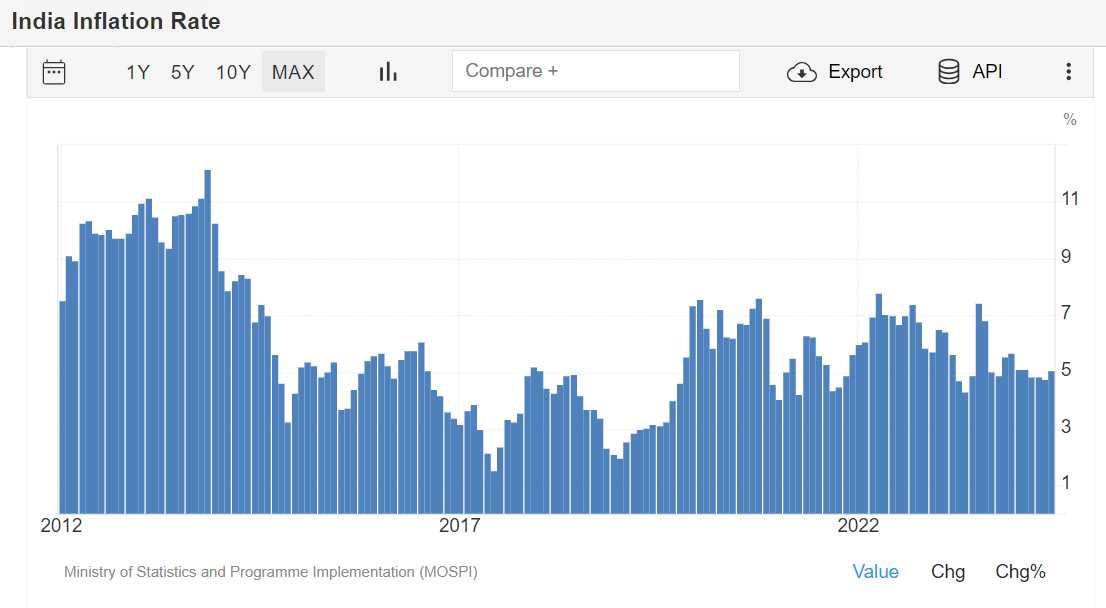🇮🇳 India: The Next Global Manufacturing Hub
India is quickly becoming a major player in the global economy, with big chances to be the next big factory for the world. With over 1.4 billion people, a fast-growing service industry, and a government working to make things better, India is full of opportunities for investors. As the world's fifth-biggest economy, India has a lot of room to grow and could change how the world does business in the years to come.
📈 Economic Growth and Global Positioning
India, the world's fifth-largest economy, has exhibited remarkable economic expansion, with its gross domestic product doubling over the past decade. This growth stems from ongoing industrialization and India's emergence as a cost-effective alternative to China.
As businesses seek to diversify their manufacturing bases due to China's geopolitical ambitions and rising production costs, India, alongside nations like Vietnam, Indonesia, and Bangladesh, is attracting increased attention.
👨🦳 Demographic Advantage and Linguistic Edge
India's population recently surpassed 1.4 billion, overtaking China as the world's most populous nation.
This demographic dividend, characterized by a youth-heavy population, could fuel economic growth for decades. Moreover, India boasts the second-largest English-speaking community globally, with 125 million English speakers, enhancing its capacity to offer global services.
💻 Service Sector Expansion and Outsourcing Potential
The service sector's contribution to India's GDP has grown substantially, accounting for approximately half of the total.
This shift has positioned India as a prime destination for outsourcing, ranging from customer support to specialized services like accounting, engineering, design, legal services, and programming. A recent example of this trend is Amazon hiring nearly 1,000 Indian workers to manually check items in their supposedly AI-equipped stores.
🧑💼 Workforce Challenges and Labor Participation
Despite its vast population, India faces an unusual workforce challenge. China exceeds India by 30% in workforce size, highlighting issues with labor force participation.
The International Monetary Fund estimates that if India could integrate its non-working women into the workforce, the country's GDP could grow by 27%. This underscores the unrealized potential within India's labor market.
🏢 Infrastructure and Development Obstacles
India's infrastructure lags significantly behind that of China, contributing to its lower GDP per capita.
The nation grapples with fundamental infrastructure challenges, including inadequate roads, unreliable electricity supply, and limited access to clean drinking water. These deficiencies, coupled with underdeveloped education and public services, block economic growth and deter foreign investment.
💳 Financial Sector and Economic Regulations
India's banking sector, dominated by state-owned institutions, has experienced a slowdown due to excessive regulation. This has resulted in limited lending to businesses and consumers, hampering economic development. Foreign direct investment has also suffered, falling from 3.6% to 1.5% of GDP, further constraining economic growth.
👤 Shadow Economy and Fiscal Challenges
Bureaucratic inefficiencies and over-regulation have boosted a substantial shadow economy, which comprised more than half of the entire economy just a few years ago. While the government is making efforts to address this issue, progress remains slow. The nation also faces budgetary pressures, with a growing deficit pushing the debt-to-GDP ratio to nearly 90%.
🫰 Economic Indicators and Investment Climate
Despite these challenges, India shows promising economic indicators. The country's export deficit has recently turned into an excess, with the current account balance improving from a record deficit of nearly $31 billion to an excess of $5.7 billion. Consumer demand is on an upward trajectory, and inflation remains relatively controlled at 5%.
Notably, India has never defaulted on its government obligations, a fact that bolsters its credibility in international financial markets.
🔮 Future Outlook and Investment Potential
India presents a complex yet potentially rewarding investment landscape. To fully capitalize on its potential and position itself as a global manufacturing hub, India must focus on three key areas:
1. Infrastructure Development: Enhancing transportation networks and basic amenities to support industrial growth.
2. Regulatory Reform: Streamlining bureaucratic processes and creating a more business-friendly environment.
3. Human Capital Investment: Improving education and healthcare systems to build a more skilled and productive workforce.
Major credit rating agencies currently assign India a rating indicating sufficient creditworthiness with moderate risks and a positive outlook for future improvements. This assessment, combined with the country's economic potential, suggests that India could emerge as a significant player in global manufacturing, provided it successfully addresses its current challenges.
In conclusion, while India's path to becoming the next global factory is not without obstacles, its demographic advantage, growing service sector, and improving economic indicators present a compelling case for its future economic projection. Investors and businesses looking to capitalize on India's potential should carefully weigh these opportunities against the existing challenges, keeping a close eye on the country's progress in addressing its infrastructural and regulatory hurdles.
This is not a financial or investing recommendation. It is solely for educational purposes.













